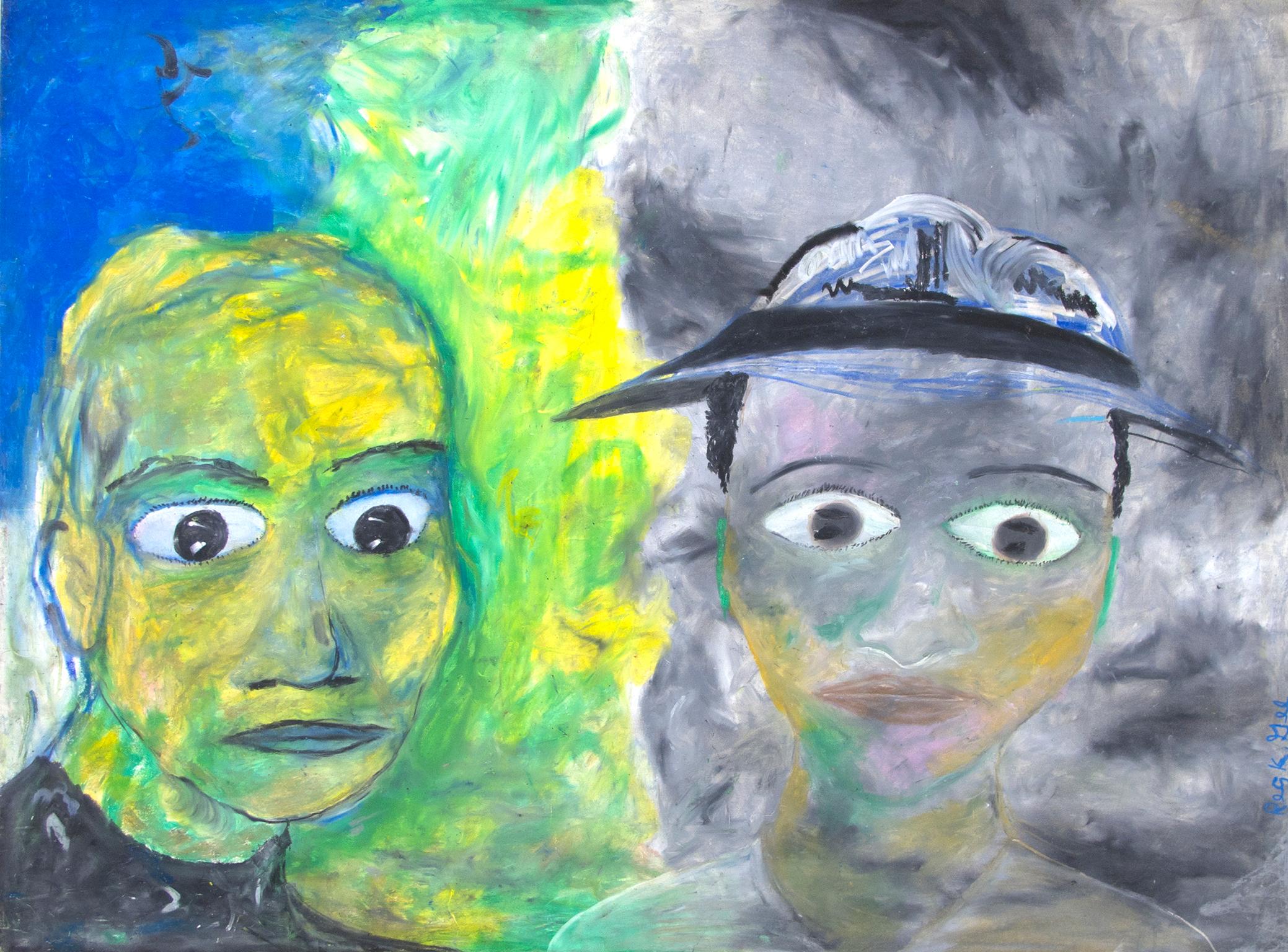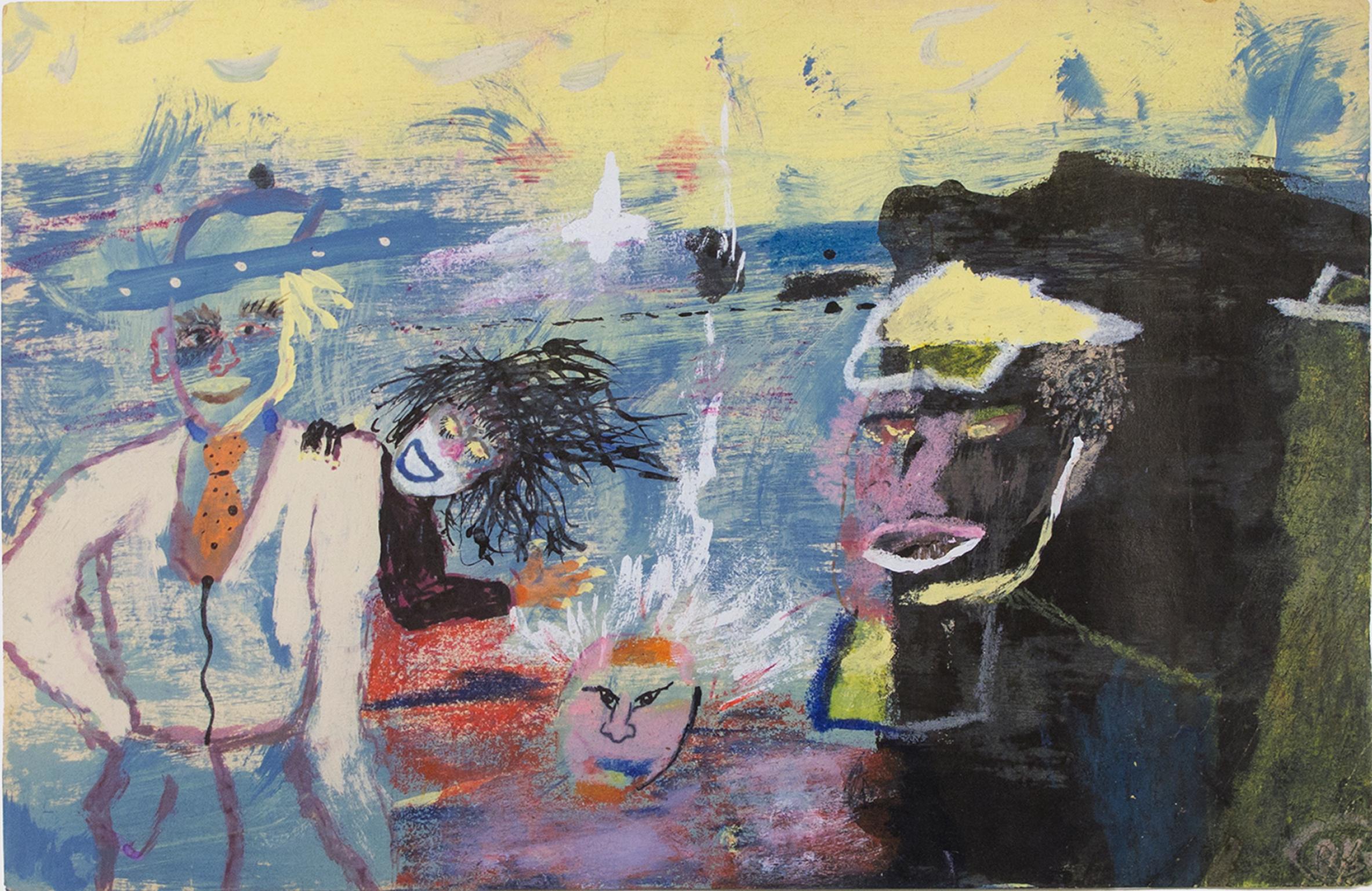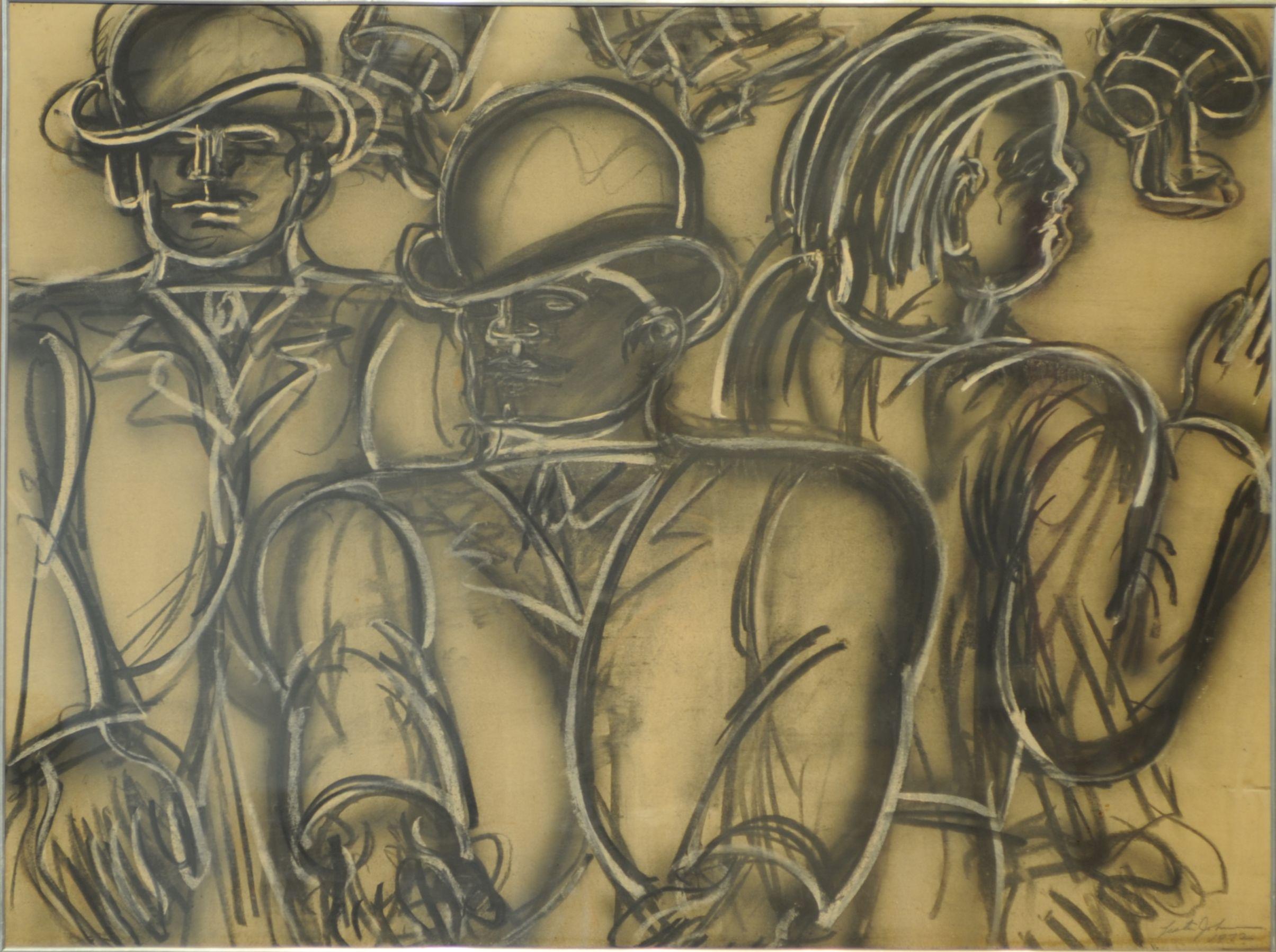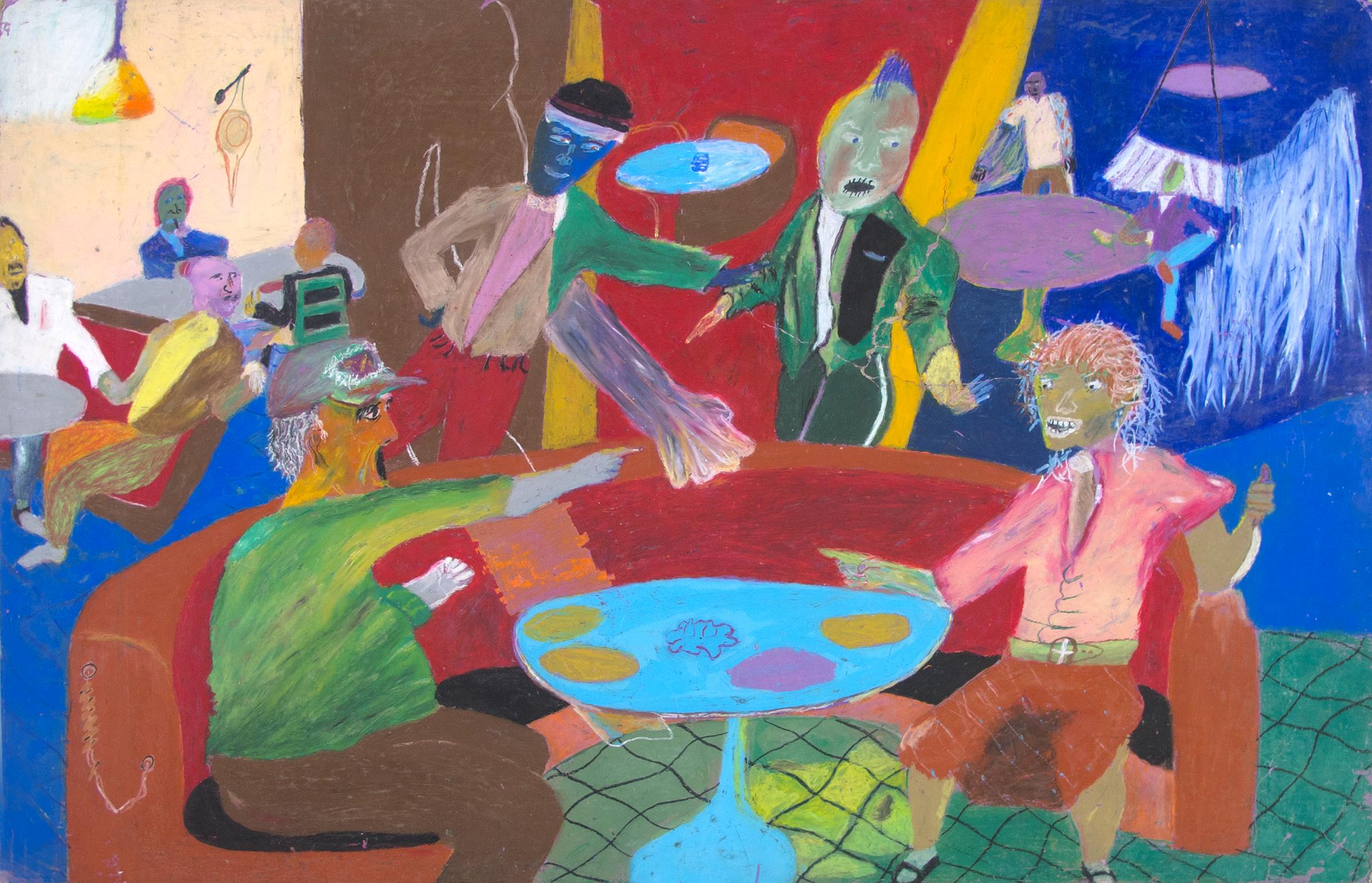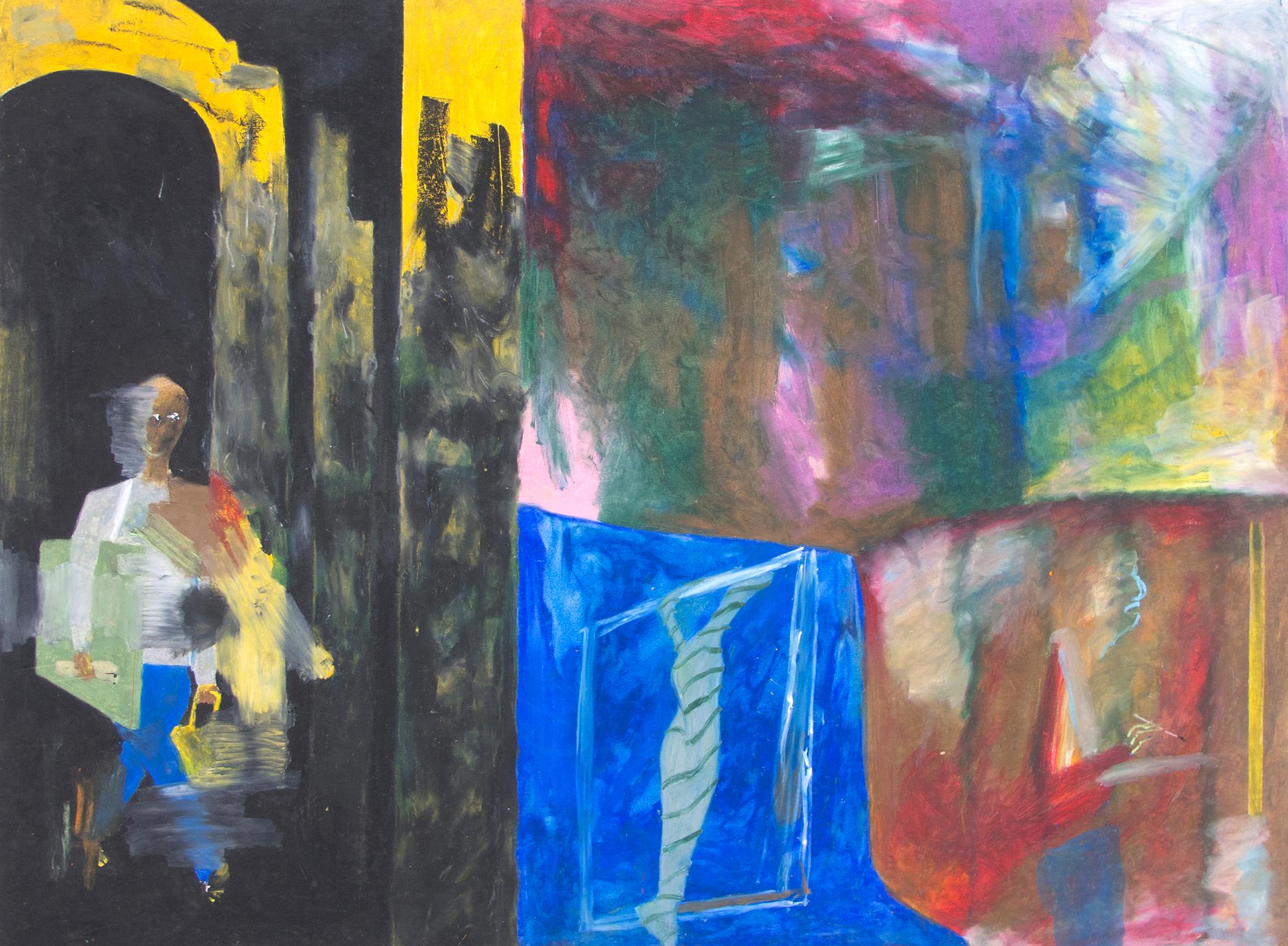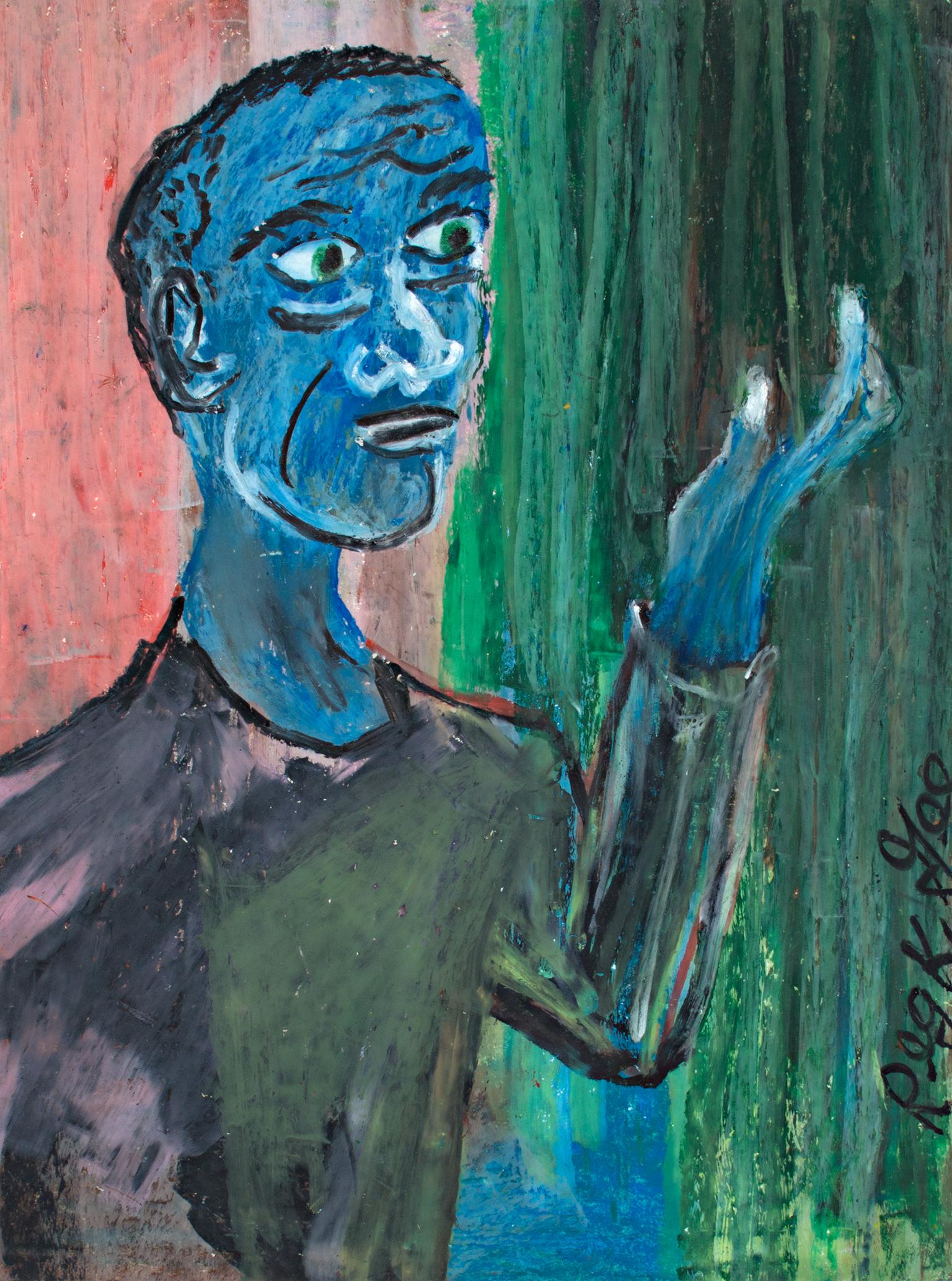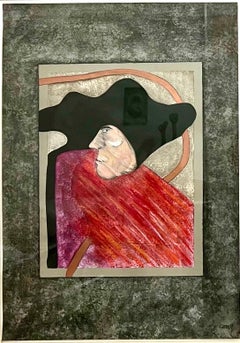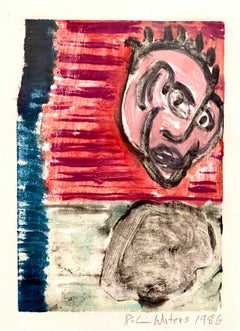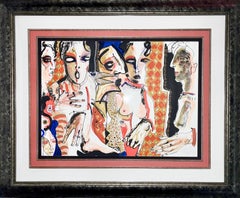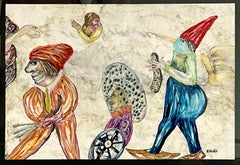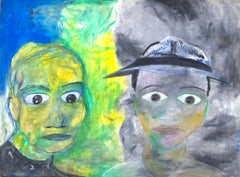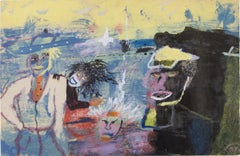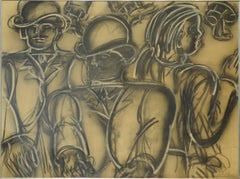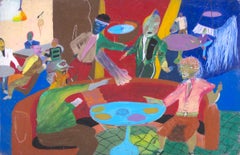Items Similar to Cuban Artist Pastel Drawing African American Emilio Cruz Bonnie & Clyde Painting
Want more images or videos?
Request additional images or videos from the seller
1 of 13
Emilio CruzCuban Artist Pastel Drawing African American Emilio Cruz Bonnie & Clyde Painting
$2,800
£2,103.44
€2,425.61
CA$3,885.37
A$4,317.50
CHF 2,262.41
MX$52,946.42
NOK 28,855.78
SEK 27,146.46
DKK 18,103.70
Shipping
Retrieving quote...The 1stDibs Promise:
Authenticity Guarantee,
Money-Back Guarantee,
24-Hour Cancellation
About the Item
Emilio Cruz (1938-2004)
Bonnie and Clyde
Pastel on paper
Hand signed lower right
Dimensions Framed H 15-7/8" W 18-1/2", Sight H 13-1/2" W 16-1/8"
Emilio Antonio Cruz (1938 – 2004) was a Cuban American artist who lived most of his life in New York City. His work is held in several major museums in the United States.
Emilio Antonio Cruz was an American Artist of Cuban descent. He was born in the Bronx on March 15, 1938. He studied at the Art Students League of New York with Edwin Dickinson, George Grosz and Frank J. Reilly and at The New School in New York City, and finally at the Seong Moy School of Painting and Graphic Arts in Provincetown, Massachusetts. As a young artist in the 1960s, Cruz was connected with other artists who were applying abstract expressionism concepts to figurative art such as Lester Johnson, Red Grooms, Mimi Gross, Bob Thompson and Jan Muller. He combined human and animal figures with imagery from archaeology and natural history to create disturbing, dreamlike paintings. Cruz received a John Hay Whitney Fellowship and awards from the Joan Mitchell Foundation and from the National Endowment for the Arts.
In the late 1968, Emilio and wife Patricia Cruz moved to St. Louis to work with Julius Hemphill and the Black Artists Group. He served as director for the visual arts program, which also included painters Oliver Jackson and Manuel Hughes. In addition to artistic contributions, the couple participated in city-wide civil rights protests and rent strikes.
Cruz moved to Chicago and taught at the School of the Art Institute of Chicago during the 1970s, where he exhibited widely and was represented by the Walter Kelly Gallery. He wrote two plays, Homeostasis: Once More the Scorpion and The Absence Held Fast to Its Presence. These were first performed at the Open Eye Theater in New York in 1981, and later were included in the World Theater Festival in Nancy and Paris, France, and in Italy. In 1982 he returned to New York where he began to exhibit again. In the late 1980s he resumed teaching at the Pratt Institute and at New York University.
Harry Rand, Curator of 20th Century Painting and Sculpture at the Smithsonian American Art Museum, described Emilio Cruz as one of the important pioneers of American Modernism of the 1960s for his fusion of Abstract Expressionist art with figuration. Geno Rodriguez, Curator and Executive Director of The Alternative Museum, wrote in 1985, "Emilio Cruz, is a brilliant and impassioned artist whose current paintings are monumental, imbued with intelligence, fury and an apt sense of irony. They reflect the turbulent world within which we live."
Geoffrey Jacques wrote in 1990, "Emilio Cruz paints humanity’s essence. Mythology and archeology are the foremost concerns of the painter Emilio Cruz. Dinosaurs, skeletal humans and fossil-like images are used in his work as metaphoric signposts in a consideration of the basic questions of existence." Art historian and curator Paul Staiti wrote in 1997, "Emilio Cruz's Homo sapiens series is a strange and haunting genealogy of the modern soul... What is at stake here more than biopolitical culture, is the remystification of the body and mapping of consciousness ... For all the trauma, explicit and implicit, Cruz's style is masterful, classical, even beautiful."
Exhibitions
Cruz held his first solo exhibition at the Zabriskie Gallery in New York in 1963. Afterwards his work was included in many group and solo exhibitions, including the Anita Shapolsky Gallery in 1986 and 1991, museum exhibitions at the Studio Museum in Harlem in 1987, the Pennsylvania Academy of the Fine Arts in 1997. In 1994, Cruz's work was shown as part of the American contingent at the IV Bienal Internacional de Pintura en Cuenca, Ecuador. Other American artists exhibiting at this show were Donald Locke, Philemona Williamson, Whitfield Lovell and Freddy Rodríguez. His last show was I Am Food I Eat the Eater of Food at the Alitash Kebede Gallery in Los Angeles in 2004.
Cruz's work is held in many collections including the Museum of Modern Art, the Brooklyn Museum, the Studio Museum in Harlem; the Smithsonian American Art Museum and National Museum of African American History and Culture, the Hirshhorn Museum and Sculpture Garden, Washington, D.C.; the Albright–Knox Art Gallery, Buffalo, New York; and the Wadsworth Atheneum, Hartford, Connecticut.
Emilio Cruz paints in an expressive style inspired by imagined events and the history of Africa and the New World.
Paintings by African Americans from the collection of the National Museum of American Art: A Book of Postcards (Washington, D.C.: National Museum of American Art in cooperation with Pomegranate Artbooks, 1991)
Awards: John Hay Whitney Foundation Fellowship, 1964 – 1965; Cintas Foundation Fellowship, 1965 – 66.
Important exhibitions: (group) Sun Gallery, Provincetown, Mass., 1959, 1960, 1961, 1963; Richard Grey Gallery, Chicago, 1963, 1964; regional exhibition Drawing Society of America, Gallery of Modern Art, New York, 1965; University of North Carolina, 1965; (one-man) Zabriskie Gallery, New York, 1963, 1965.
Free Within Ourselves: African-American Artists in the Collection of the National Museum of American Art, 1996.
Along with Henry Ossawa Tanner, Elizabeth Catlett, Lois Mailou Jones, Romare Bearden & Robert Thompson.
Ten Negro Artists from the United States: First World Festival of Negro Arts, Dakar, Senegal, 1966 along with Barbara Chase, Emilio Cruz, Sam Gilliam, Richard Hunt, Jacob Lawrence, William Majors, Norma Morgan, Robert Reid, Charles White, and Todd Williams.(New York: United States Committee for the First World Festival of Negro Arts, Inc., 1966)
- Creator:Emilio Cruz (1938 - 2004, Cuban, American)
- Dimensions:Height: 15.88 in (40.34 cm)Width: 18.5 in (46.99 cm)
- Medium:
- Movement & Style:
- Period:
- Condition:
- Gallery Location:Surfside, FL
- Reference Number:1stDibs: LU38216640492
About the Seller
4.9
Platinum Seller
Premium sellers with a 4.7+ rating and 24-hour response times
Established in 1995
1stDibs seller since 2014
1,782 sales on 1stDibs
Typical response time: <1 hour
- ShippingRetrieving quote...Shipping from: Surfside, FL
- Return Policy
Authenticity Guarantee
In the unlikely event there’s an issue with an item’s authenticity, contact us within 1 year for a full refund. DetailsMoney-Back Guarantee
If your item is not as described, is damaged in transit, or does not arrive, contact us within 7 days for a full refund. Details24-Hour Cancellation
You have a 24-hour grace period in which to reconsider your purchase, with no questions asked.Vetted Professional Sellers
Our world-class sellers must adhere to strict standards for service and quality, maintaining the integrity of our listings.Price-Match Guarantee
If you find that a seller listed the same item for a lower price elsewhere, we’ll match it.Trusted Global Delivery
Our best-in-class carrier network provides specialized shipping options worldwide, including custom delivery.More From This Seller
View AllCuban Art Abstract Oil Painting Latin American Mixed Media Ramon Carulla
By Ramon Carulla
Located in Surfside, FL
Ramon Antonio Carulla (Cuban, born 1936).
Artist signature to lower right. Label verso. Retains original JOY MOOS GALLERY label.
Dimensions: 38.5 X 28 inches. Paper is 28 X 19.5 inches.
This painting is a mixed media with oil paint, on paper
It is hand signed recto and signed and titled verso.
An abstract naive, folk art, work depicting a male figure with geometric forms.
Ramon Carulla, born in Havana, Cuba in 1936 moved to the United States in 1967. He has exhibited widely throughout the United States, Latin America and Europe. He has participated in personal and group exhibitions in Canada, Venezuela, Mexico and Spain and throughout the USA.
Select Gallery Exhibitions:
Lowe Art Museum (Coral Gables, Florida),
The Museum of Fine Arts (Montreal, Canada),
The International Monetary Fund (Washington, D.C.)
The Art Expo (New York City).
Select Awards:
First Prize at the VI Graphic Biennial of Latin America (1983; San Juan, Puerto Rico),
the Silvia Daro Dawidowicz Award for Painting (1980; Metropolitan Museum)
the Samuel Golan Award (1982, Fine Art Auction Exhibition; CH 2, Miami, Florida).
the Cintas Fellowship (Institute of International Education; United Nations, New York)
SELECTED INDIVIDUAL EXHIBITIONS
2005 Sonnet Gallery (Sarasota, Florida)
2000 Ramon Carulla: People and Places - Corbino Galleries,
1998 The Dreamers - Cuban Collection Fine Art (Coral Gables, Florida)
1997 The Immigrant Series – Metro-Dade Cultural Resource Center (Miami, Florida)
1996-96 Ramon Carulla: Works on Paper – PJorn (Hamburg, Germany)
1994 Ramon Carulla: New Paintings, Plates & Boxes – The Barbara Scott Gallery
Rostros para recordar – Galería Traz (Mexico City, Mexico)
1993 Ramon Carulla, Exhibición Personal – Contemporary Art Museum (Panama)
1992 Ramon Carulla: Recent Work - The Barbara Scott Gallery (Bay Harbor, Florida)
1991 Cabinet Room – The Capitol (Tallahassee, Florida)
1988 Sofa & Hostage Series – Jay Moos Gallery
1987 20 Years After – Bacardi Art Gallery (Miami, Florida)
1985 Malcom Brown Gallery – (Cleveland, Ohio)
Mask Series – Forma Galley (Miami, Florida)
Masks, Hats, Other Headgear: A Retrospective - Schweyer-Gallardo Gallery
1983 Recent Works – VI Graphic Biennial (San Juan, Puerto Rico)
1980 Life Boundaries Series – Virginia Miller Gallery (Coral Gables, Florida)
1975 Atelier J. Lukacs (Montreal, Canada)
1967 Bacardi Art Gallery (Miami, Florida)
Ramón Antonio Carulla (born December 7, 1936 in Havana, Cuba) is a Cuban art...
Category
1970s Modern Figurative Paintings
Materials
Paper, Oil
Conceptual Pop Art Color Oil Monotype Painting Abstract Figure Robin Winters
By Robin Winters
Located in Surfside, FL
Robin Winters (American, born 1950),
Untitled (Red Face) from "Cherry Block Series" 1986, monotype, pencil signed and dated lower right, plate: 6"h x 8.5"w, overall (with frame): 22.25"h x 18.25"w. Provenance: Property from a Private Collection, San Francisco.
Winters was invited to make monotypes at Experimental Workshop in San Francisco, (they printed Richard Bosman, Sam Francis, Claire Falkenstein, Deborah Oropallo and Kenneth Noland and many more greats). Winters chose to paint on wood blocks rather than the more usual metal plates in order to capture the organic quality of the natural material. He exploited a salient characteristic of the monoprint in Ghost Story by adding new painted elements onto the increasingly faint ghost images that result from successive impressions from a single block. In so doing he achieved the effect of transparent layers of color and shadow imagery. Winters's brightly-colored monotypes portray an array of figures and landscapes (and an occasional still-life) that, although can be seen in the context of a general trend away from abstraction that has marked the 1980s, defy strict stylistic categorization. They are neither realistic nor abstract, psychological self-examinations nor narrative fictions, but they contain elements of all of these approaches. Like Jonathan Borofsky, Winters derives much of his subject matter from dreams, believing that through his private fears and obsessions he can touch similar emotions in others. Although at first glance Winters's images look as if they could have been made by a child, closer attention reveals sly art historical references to Jackson Pollock and Pattern Painting (the drip and splatter backgrounds), Mark Rothko (the three-part horizontal compositions) and Minimalism (the gridded Cherry Block Series: Bread Beat).
Robin Winters (born 1950 in Benicia, California) is an American conceptual, multi-disciplinary, artist and teacher based in New York. Winters is known for creating solo exhibitions containing an interactive durational performance component to his installations, sometimes lasting up to two months. Winters first emerged in the burgeoning Soho NYC art scene of the 1970s. An early practitioner of the Relational Aesthetics (social interaction as an art medium) Winters also created in works through sculpture, installation, performance, painting, drawing and prints. His art maintains a whimsical spirit, and he often returns to ongoing themes involving faces, boats, cars, bottles, hats and jesters or fools. Winters has incorporated such devices as blind dates, double dates, dinners, fortune telling, and free consultation in his performances. Throughout his career he has engaged in a wide variety of media, such as performance art, film, video, writing prose and poetry, photography, installation art, printmaking, drawing, painting, ceramic sculpture, bronze sculpture, and glassblowing.
Winters was born in Benicia, California in 1950 to lawyer parents. As a child his hobby was collecting glass bottles found on the beach and under old buildings, which would later influence him as an artist. In 1968, Winters had his first durational performance, entitled Norman Thomas Travelling Museum. The artist drove a Volkswagen bus decorated in collage, many of the images relating to current events and politics. Inside was what the artist described as a “reliquary” containing many objects, including a bottle collection. Winters took the van to shopping centers and even as far as Mexico. That same year, Winters opted not to register for the military draft. Although he was deemed fit to serve, Winters refused. In 1975 the resulting legal proceedings finally came to a close after it was proven that the artist had been harassed by the local draft board. In his teens and early twenties, Winters became acquainted with several local artists who helped shape his aesthetic, most notably Manuel Neri and Robert Arneson. By the early 1970s, Winters was studying at the San Francisco Art Institute (SFAI) and had relocated to San Francisco. At this time Winters became friends with the Bay Area conceptual artists Terry Fox and Howard Fried, and participated in several of Fried's performance works. In 1972 Winters was accepted into the Whitney Independent Study Program in New York City. After coming to New York City, Winters helped support himself by working for various artists, among them the performance artist Joan Jonas and sculptor Donald Judd. In 1974, Winters performed The Secret Life of Bob-E or Bob-E Behind the Veil eight hours a day, five days a week for a month in his studio apartment. Behind a one-way mirror the audience could watch Winters play the character of Bob-E, whose goal was to make a monument for everyone in the world in the form of blue and yellow rubber top hats. By the end of the month the artist had constructed 262 hats. The following year, Winters was invited to take part in the Whitney Museum's 1975 Biennial Exhibition. Entitled W.B. Bearman Bags a Job or Diary of a Dreamer. Winters was traveling in 1975 and 1976, spending time in North Africa and in Europe. At a time when most young American artists were unaware of their European counterparts, Winters met and was influenced by such artists as Sigmar Polke and Marcel Broodthaers (with whom Winters worked on an installation) and also had a one-person exhibition, at the Konrad Fischer Gallery in Dusseldorf. Returning to New York in 1976, Winters teamed up with a group of artists to form Collaborative Projects (Colab), a rather anarchistic organization dedicated to artistic collaboration and the creation of art that questioned social values.. Also in 1976, Winters formed the partnership “X&Y” with fellow artist Coleen Fitzgibbon that would last two years. Together they performed a series of shows in the Netherlands, most notably a show entitled Take the Money and Run. Performed at De Appel in Amsterdam, the show involved the artists robbing their audience. The following day the audience was given an apology, as well as the opportunity to retrieve any valuables and participate in a lottery to win the artists’ services. They also made a Super 8 film in NY called Rich-Poor, in which they asked people on the streets their thoughts on the rich and poor.
In 1980 Winters participated in The Real Estate Show and in Absurdities at ABC No Rio. That same year he and artists Peter Fend, Coleen Fitzgibbon, Peter Nadin, Jenny Holzer, and Richard Prince also formed The Offices of Fend, Fitzgibbon, Holzer, Nadin, Prince & Winters. This short-lived collective was based out of an office on lower Broadway and offered “Practical Esthetic Services Adaptable to Client Situation”, as stated on their business card. Their goal was to offer their art as “socially helpful work for hire”. In June of that year Winters participated in The Times Square Show, Colab's most well-known exhibition. The month-long show took place in a four floor building on West 41st Street and was densely packed with art. To cap off a busy year, Winters also became one of the first artists to join the Mary Boone Gallery, showing a successful solo exhibition in 1981. His work was shown in the New York/New Wave show in 1981 at MoMA PS1 along with Jean-Michel Basquiat, Roberta Bayley, William S. Burroughs, David Byrne, Sarah Charlesworth, Larry Clark, Crash (John Matos), Ronnie Cutrone, Brian Eno, Peter Fend, Nan Goldin, Keith Haring, Ray Johnson, Joseph Kosuth, Marcus Leatherdale, Christopher Makos, Robert Mapplethorpe, Elaine Mayes, Frank Moore, Kenny Scharf and others. In 1982, Winters had his first solo exhibition in Los Angeles at the Richard Kuhlenschmidt Gallery. At the Mo David Gallery in 1984, Winters created an installation piece that consisted of a floor of plaster tiles. Underneath each tile, hidden from view, was a drawing. He designed the stage sets for the musician Nico, and assisted French artist Orlan, American artist Stuart Sherman, and American poet Gregory Corso. Two years later Winters was invited to take part in Chambres d’Amis (In Ghent there is Always a Free Room for Albrecht Durer) in Ghent, Belgium. In it, 51 artists created installations in 50 different sites, mostly private homes. Winters chose the home of a local art historian. The artist made 90 drawings based on images found in the large collection of art books in the home's library. He made two copies of each drawing and placed the originals in the books themselves. One set of copies was exhibited in the sponsoring museum, Museum van Hedendaagse, as "The Ghent Drawings". The drawings were also on display at Winters’ solo exhibition at Luhring Augustine & Hodes Gallery in New York City in 1987.
In 1986, Winters had a solo exhibition at Maurice Keitelman Gallery in Brussels, Belgium, and the following year a solo exhibition at the Centre Régional d'Art Contemporain Midi-Pyrénées in Toulouse, France. Also in 1986, Winters' Playroom was held at the Institute for Contemporary Art in Boston, Massachusetts. The exhibition was part of Think Tank, a retrospective of Winters' work which traveled to the Stedelijk Museum in the Netherlands, the Centre Regional d’Art Contemporain in France, and the Contemporary Arts Center in Ohio. Winters spent a month in 1989 working with students at the San Francisco Art Institute. Never having worked with ceramics, he spent the month making numerous ceramic pieces, which were then shown in the aptly named One Month in San Francisco. Other components of the piece included Winters’ childhood bottle collection and a video showing each piece in the show filmed briefly next to a ruler.[ Also that year, Robin served as a visiting artist at the Pilchuck Glass School, where he met artist John Drury, who was then working as the school's artist liaison.
In the summer of 1990, Winters interviewed fellow artist Kiki Smith for her eponymous book, which was published later that year. That same year (1990), Winters was invited by the Val Saint Lambert glass factory in Belgium to create glassworks in their facility. Winters, artists John Drury and Tracy Glover...
Category
1980s Pop Art Figurative Paintings
Materials
Monoprint, Monotype
Large Mexican Figurative Expressionist Lithograph Women Juan Sebastian Barbera
Located in Surfside, FL
Juan Sebastian Barbera (Spanish, Born 1964 )
Litho on Guarro Paper
Titled : La Comision (from the Los Conjuros Suite)
Circa, 1994.
Hand signed in pencil lower right with edition size number 62 / 75.
Frame: 38" X 46"
Image: 22" X 30"
Juan Sebastián Barberá Durón Plastic artist Cd. de México 1964 Son of the great musical artist Luisa Duron, Mexican harpsichordist, daughter of pianists Jesús Durón Ruiz and Julia Crespo considered a pioneer of the movement and musical flourishing of the Renaissance and Baroque periods and the initiator of the harpsichord school in Mexico .he grew up in an almost Renaissance environment, among artists and under the main protection of the baroque music of Bach and Hotteterre, Couperin and Scarlatti , among others. Since a very young age, he had a great talent for drawing, painting and sculpture and at the age of ten he won the National School contest of art. From there on, he studied painting and engraving with significant teachers, and was dedicated in a very clear way to the plastic arts from the age of 17 years, after a mystical trip to India. He continued his studies at the academy of San Carlos...
Category
20th Century Abstract Expressionist Figurative Prints
Materials
Lithograph
Cuban Art Abstract Oil Painting Latin American Ramon Carulla Surrealist Folk Art
By Ramon Carulla
Located in Surfside, FL
Ramon Antonio Carulla (Cuban, born 1936).
Oil paintings on paper. Titled "When Dreams Become Reality"
Artist signature lower right. Title on verso.
Retains original Joy Moos Gallery label. Sheet measures measures approximately 14 in. x 22 in. (paper). Framed 20.5 X 28.5
This painting is a mixed media with oil paint, on paper
It is hand signed recto and signed and titled verso.
An abstract naive, folk art, work depicting depicts colorful imaginative Surrealist figures. .
Ramon Carulla, born in Havana, Cuba in 1936 moved to the United States in 1967. He has exhibited widely throughout the United States, Latin America and Europe. He has participated in personal and group exhibitions in Canada, Venezuela, Mexico and Spain and throughout the USA.
Select Gallery Exhibitions:
Lowe Art Museum (Coral Gables, Florida),
The Museum of Fine Arts (Montreal, Canada),
The International Monetary Fund (Washington, D.C.)
The Art Expo (New York City).
Select Awards:
First Prize at the VI Graphic Biennial of Latin America (1983; San Juan, Puerto Rico),
the Silvia Daro Dawidowicz Award for Painting (1980; Metropolitan Museum)
the Samuel Golan Award (1982, Fine Art Auction Exhibition; CH 2, Miami, Florida).
the Cintas Fellowship (Institute of International Education; United Nations, New York)
SELECTED INDIVIDUAL EXHIBITIONS
2005 Sonnet Gallery (Sarasota, Florida)
2000 Ramon Carulla: People and Places - Corbino Galleries,
1998 The Dreamers - Cuban Collection Fine Art (Coral Gables, Florida)
1997 The Immigrant Series – Metro-Dade Cultural Resource Center (Miami, Florida)
1996-96 Ramon Carulla: Works on Paper – PJorn (Hamburg, Germany)
1994 Ramon Carulla: New Paintings, Plates & Boxes – The Barbara Scott Gallery
Rostros para recordar – Galería Traz (Mexico City, Mexico)
1993 Ramon Carulla, Exhibición Personal – Contemporary Art Museum (Panama)
1992 Ramon Carulla: Recent Work - The Barbara Scott Gallery (Bay Harbor, Florida)
1991 Cabinet Room – The Capitol (Tallahassee, Florida)
1988 Sofa & Hostage Series – Jay Moos Gallery
1987 20 Years After – Bacardi Art Gallery (Miami, Florida)
1985 Malcom Brown Gallery – (Cleveland, Ohio)
Mask Series...
Category
1970s Modern Figurative Paintings
Materials
Paper, Oil
Large Venezuelan Expressionist Oil Painting Diego Barboza Latin American Master
Located in Surfside, FL
Diego Barboza - 1945-2003
Hand signed and dated 1988 Oil on Canvas
Diego Barboza was born the Carabobo street of Maracaibo, Venezuela on February 4, 1945. He was a Venezuelan Neo Figurative Painter who is among the most famous and influential figures in Venezuelan art history. Diego Barboza opened a new chapter in Latin America, beyond the surreal or the magical realism of the Modern Latin American Masters. He created a new language of dislocation and transgression. Personages became distorted to the point that was very exaggerated forms His figures twisted and contorted without losing their presence or their pull. Extremities muscles, and bones burst into an explosive compound of divergent and convergent lines. Through eruptive brushstrokes and fractured outlines. Barboza created a world of illusions.
Barboza was born into a upper-middle-class family. He stopped going to school at 12 years old, and he registered himself at the School of Visual Art in the City of Maracaibo Venezuela. Barboza studied at the School of Visual Arts in Caracas, Venezuela. Barboza began his training as an artist at age 12 in his native Maracaibo when he left formal education to enroll in the then School of Plastic Arts of Zulia, then Julio Arraga School of Plastic Arts, where he was a student in the modeling, collage and Drawing of Angelina Curiel. His first collages, in the sixties, show the influence of American Pop Art. In 1967 he exhibited at the Ateneo de Caracas his series 'Los Ratones', a proposal then 'criticized by critics as unprecedented in Venezuela'. In his tribute to the film "Nosferatu" Friedrich Murnau included 32 drawings as well as two-dimensional objects. In 1968 he moved to London where he studied at the London College of Printing. From that time is his '30 Girls with Nets', an action in which 30 students of the London College of Printing, dressed in black and covered by white nets, toured London public places, behaving naturally. His 'street expressions', which he later called 'poetic actions', symbolized a breakdown of social restraints through unusual behaviors that sought to provoke public reactions. Upon his return to Venezuela in 1973, Barboza continues with this line of work, being recognized as one of the initiators of Venezuelan conceptual art. In the 1980's Diego Barboza turned to painting, the New Venezuelan Figuration. Here belongings and the feminine figure fill the work of that time, in which he embodied his intimacy and daily life through scenes of furnishings and flowers that included objects from his workshop and home. His nudes were made from live model, then to follow the path of distortion resulting in their unmistakable females: a figure that represented their personal way of appreciating beauty. Barboza presented his first individual exhibition at the Centro de Bellas Artes of Maracaibo Venezuela. In 1963, he traveled to London when the Conceptual Art movement started, he had the support of the London New Art Lab Gallery. On March 7, 1970 Barboza displayed his first work on Conceptual Art, which he called Art of Action. In London with the performance of 30 Girls with nets (30 Muchachas con redes). His second work was Nets and Hats in markets and restaurants (Con sombreros y redes en mercados y restaurantes). In London UK. His third The Centerpiece (El Ciempies) and the fourth Expression on a laundry-mat (Expresiones en una lavandería)
In 1974. Baboza returned to Venezuela. Where he presented two very important Conceptual Art works: The Armadillo Box (La Caja del Cachicamo) and from the School of Athens to the New School of Caracas (De la Escuela de Atenas a la Nueva Escuela de Caracas). Closing his cycle of Conceptual Art creation. IN Venezuela a sort of impromptu academy started up at Claudio Perna’s house. Eugenio Espinoza, Roberto Obregón, Antonieta Sosa, Alfred Wenemoser, Yeni and Nan, Sigfredo Chacón, Diego Barboza, Luis Villamizar, Margherita D’Amico, Pedro Terán, Alfredo del Mónaco, as well as international figures who happened to be visiting Venezuela such as Antoni Muntadas, Charlotte Moorman, and Roman Polanski would gather there. Venezuela, especially Caracas, was a rich field of action for modernism in South America. Venezuelan Geometric Abstraction, Op art and Kinetic Art dominated through crucial figures like Jesús Rafael Soto, Gego, Alejandro Otero, and Carlos Cruz Diez, the country’s kinetic art made a fundamental contribution internationally. The Greater London Arts Association and the Arts Council of Great Britain did several exhibitions of (North, Central, South, London, Wales, Scotland and Ulster) to show the actual Visual Arts in all of the United Kingdom and Diego Barboza was invited for this event with a solo exhibition, expressions around a cylinder (Expresiones alrededor de un cilindro).
Diego has made numerous solo and group exhibitions, obtaining rewards since 1963. He is represented in the most important museums of Venezuela, as well as in England, Brazil, Colombia and Cuba. In 1986 he was awarded the Municipal Visual Arts Award of the Municipal Council of the Federal District and in 1997 he received the National Prize for Plastic Arts granted by the National Council of Culture, CONAC.
Select Group Exhibitions
1964 Ateneo de Caracas, Caracas, Venezuela
1965 Salón Arturo Michelena, Valencia, Venezuela
1968 Salón Oficial Museo de Bellas Artes, Caracas, Venezuela
1971 Art Spectrum London, London, Great Britain
1972 Serpentine Gallery, London, Great Britain
1973 Midland Group Gallery, London, Great Britain
1974 Galería BANAP, Caracas, Venezuela
1975 Casa de Las Américas, La Habana, Cuba
Museo de Bellas Artes, Caracas
Galería de Arte Nuevo, Buenos Aires, Argentina
1976 Museo de Arte Moderno, Bogotá, Colombia
Museo de Arte Contemporáneo, Sao Paulo, Brazil
Museo de la Tertulia, Cali, Colombia
Bienal de Venecia, Venecia, Italy
1979 Centro de Artes y Comunicación, Buenos Aires, Argentina
1980 Galería NBC, Memphis, Tennessee, USA
1981 Galería de Arte Nacional, Caracas, Venezuela
Museo de Arte Contemporáneo, Medellín, Colombia
Museo de Bellas Artes, Caracas, Venezuela
1986 Museo de Arte La Rinconada, Caracas, Venezuela
1989 Galería Venzor, Chicago, Illinois, USA
1990 Museo Bellas Artes, Santiago de Chile, Chile
1992 Ambrosino Gallery, Coral Gables, Florida, USA
1993 Museo de Arte de Petare, Caracas, Venezuela
Centro de Arte Lia Bermúdez, Maracaibo, Venezuela
1994 Galería Namia Mondolfi, Caracas, Venezuela
1995 Galería Art Nouveau, Maracaibo, Venezuela
Galería Cesar Sassòn, Caracas, Venezuela
Maremares Resort, Puerto La Cruz, Venezuela
Galería Durban, Caracas, Venezuela
Galería Odalys, Caracas, Venezuela
1996 Centro de Arte Grupo Li, Caracas, Venezuela
Galería Uno, Caracas, Venezuela
Centro Cultural Consolidado, Caracas, Venezuela
Espacios Unión, Caracas, Venezuela
Hebraica, Caracas, Venezuela
1997 Sociedad Dramática, Maracaibo, Venezuela, Venezuela
CELARG, Caracas, Venezuela
Galería Ocre Arte, Caracas, Venezuela
Museo de Arte Contemporáneo , Maracay, Venezuela
Galería Medicci, Caracas, Venezuela
Awards
1963 Premio Estímulo - IX Salón d’Empaire, Maracaibo, Venezuela
1964 Premio José Ortìn Rodríguez - X Salón d’Empaire, Maracaibo, Venezuela
1965 Primer Premio de Dibujo - III Salón Pez Dorado, Caracas, Venezuela
1968 Premio Henrique Otero Vizcarrondo - XXIV Salón Oficial Anual de Arte Venezolano Museo de Bellas Artes,
1973 Premio Emilio Boggio...
Category
1980s Neo-Expressionist Figurative Paintings
Materials
Canvas, Oil
Mexican Siesta Pastel Drawing Ecole D'Paris, WPA, Bezalel Artist
By Jacques (Jakub) Zucker
Located in Surfside, FL
Jacques Zucker was born in 1900 in Radom, Poland. He was a notably famous Jewish American artist mostly known for his expressionist figure paintings. In his young years he traveled t...
Category
20th Century Modern Figurative Paintings
Materials
Pastel
You May Also Like
"The Mood, " Portrait Oil Pastel on Illustration Board signed by Reginald K. Gee
By Reginald K. Gee
Located in Milwaukee, WI
"The Mood" is an original oil pastel drawing on illustration board by Reginald K. Gee. The artist signed the piece lower right. This piece features a double portrait--one man in vibr...
Category
1990s Contemporary Portrait Drawings and Watercolors
Materials
Oil Pastel, Illustration Board
"Image, " Abstract Figurative Acrylic & Pastel on Paper signed by Reginald K. Gee
By Reginald K. Gee
Located in Milwaukee, WI
"Image" is an original acrylic and pastel painting on paper by Reginald K. Gee. The artist initialed the piece on the back. It features abstracted, simplified figures and faces in fr...
Category
1980s Contemporary Figurative Paintings
Materials
Pastel, Acrylic
untitled
By Lester Johnson
Located in New York, NY
Lester Johnson untitled charcoal, conte crayon, and spray enamel on board from 1972. Framed.
Category
1970s Other Art Style Figurative Drawings and Watercolors
Materials
Conté, Charcoal, Spray Paint, Board
$12,000 Sale Price
20% Off
"Faraway from Familiar Sounds, " Oil Pastel Drawing signed by Reginald K. Gee
By Reginald K. Gee
Located in Milwaukee, WI
"Faraway From Familiar Sounds" is an original oil pastel drawing on ragboard by Reginald K. Gee. The artist signed the piece on the back. It depicts a number of abstracted figures se...
Category
1980s Contemporary Figurative Drawings and Watercolors
Materials
Oil Pastel
"Freelance, " Oil Pastel on Illustration Board signed by Reginald K. Gee
By Reginald K. Gee
Located in Milwaukee, WI
"Freelance" is an original oil pastel drawing on illustration board by Reginald K. Gee. The artist signed the piece on the back. It depicts an artist walking through an abstracted wo...
Category
1980s Contemporary Figurative Drawings and Watercolors
Materials
Oil Pastel, Illustration Board
"The Wonder of Human Hand, " Pastel Portrait on Paper signed by Reginald K. Gee
By Reginald K. Gee
Located in Milwaukee, WI
"The Wonder of Human Hand" is an original pastel drawing on paper by Reginald K. Gee. The artist signed the piece lower right. This piece features a blue-skinned man looking at his o...
Category
1990s Contemporary Figurative Drawings and Watercolors
Materials
Pastel
